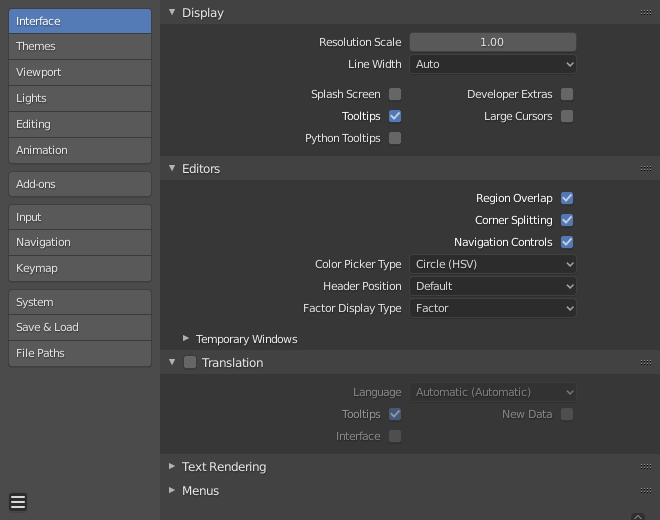Interface¶
Interface configuration lets you change how UI elements are displayed and how they react.

Display¶
- Resolution Scale
Adjusts the size of fonts and buttons relative to the automatically detected DPI. During typical usage, you may prefer to use zoom which is available in many parts of Blender interface.
- Line Width
Scale of lines and points in the interface e.g. button outlines, edges and vertex points in the 3D View.
Thin, Auto, Thick
- Splash Screen
Display the Splash Screen when starting Blender.
- Tooltips
When enabled, a tooltip will appear when your mouse pointer is over a control. This tip explains the function of what is under the pointer, gives the associated hotkey (if any).
- Python Tooltips
Displays a property’s Python information below the tooltip.
- Developer Extras
Show settings and menu items which are intended to help developers, this includes:
- Button Context Menu
- Online Python Reference
To open the Python reference manual.
- Copy Python Command
To copy the expression used when pressing the button.
- Edit Source
To edit Python source code that defines the button.
- Edit Translation
The option to edit UI translations (only available when the Manage UI translations add-on is also enabled).
- 3D View
- Show Indices
The option to show mesh vertex/edge/face indices in the overlay popover.
- Preferences
- Experimental Tab
Work in progress features can be enabled here which are currently being tested.
- Large Cursors
Use large mouse cursors when available.
Editors¶
- Region Overlap
This makes regions overlap the viewport. It means that the Toolbar and Sidebar regions, will be displayed overlapping the 3D Viewport.
- Corner Splitting
Split & join by dragging from the corners.
When disabled, you can use the context menu for area separators to perform these operations.
- Navigation Controls
Show navigation controls at top right of the window.
This impacts the 3D Viewport as well as image spaces.
Note
If you’re familiar with navigation key shortcuts, this can be disabled.
- Color Picker Type
Choose which type of color space you prefer. It will show when clicking LMB on any color field.
See the different color picker types at the Color picker page.
- Header Position
The default header position.
Using default uses top for most window types and the positions saved in the file. Otherwise you can choose to force top/bottom header alignment.
- Factor Display Type
How factor value types are displayed in the user interface.
- Factor
Values are displayed as float numbers between 0.0 and 1.0.
- Percentage
Values are expressed as a percentage between 0 and 100.
Temporary Windows¶
When performing certain operations, Blender will open a new window. The behavior of these operations can be configured here.
- Render In
When rendering, the user interface can be do any of:
- Keep User Interface
The user interface does not change and the render is computed in the background.
- Full Screen
A new Image editor is opened as a temporary window in full screen mode.
- Image Editor
The area that is the largest on screen is replaced placed by a temporary Image editor.
- New Window
A new Image editor is opened as a regularly sized temporary window.
- File Browser
When opening files from the computer, the user interface can be do any of:
- Full Screen
A new File Browser editor is opened as a temporary window in full screen mode.
- New Window
A new File Browser editor is opened as a regularly sized temporary window.
Translation¶
Blender supports a wide range of languages, enabling this checkbox will enable Blender to support International Fonts. International fonts can be loaded for the User Interface and used instead of the font bundled with Blender by default.
This will also enable options for translating the User Interface through a list of languages and tips for Blender tools which appear whenever the mouse pointer hovers over a tool button.
Blender supports I18N for internationalization. For more Information on how to load International fonts, see: Editing Texts page.
Text Rendering¶
- Anti-aliasing
Enable interface text anti-aliasing. When disabled, texts are rendered using straight text rendering (filling only absolute pixels).
- Hinting
Adjust font hinting, controls the spacing and crispness of text display.
- Interface Font
Replacement for the default user interface font.
- Mono-space Font
Replacement for the default mono-space interface font (used in the Text editor and Python Console).